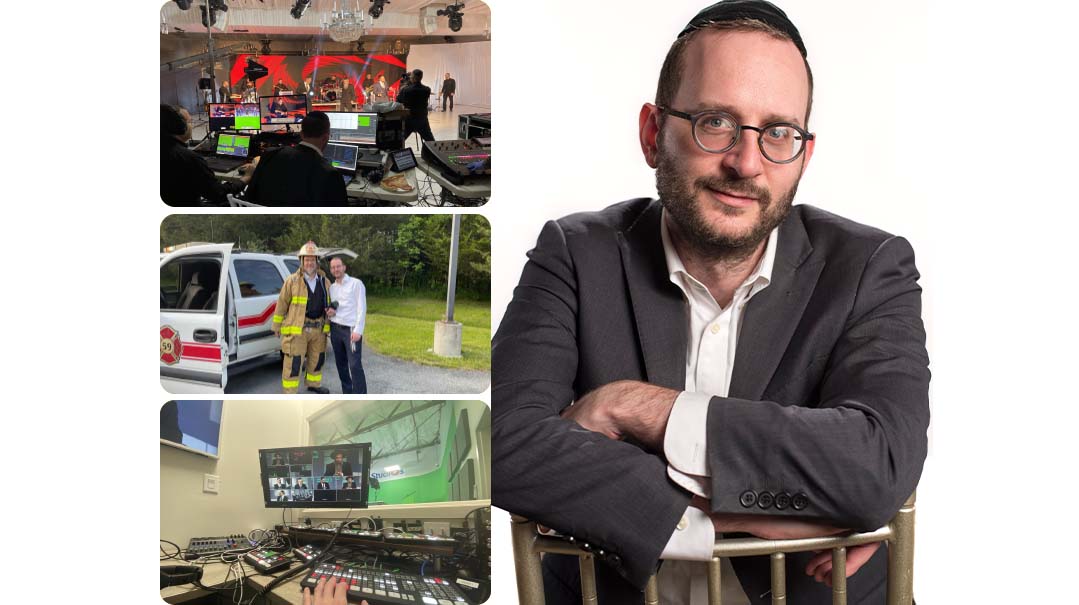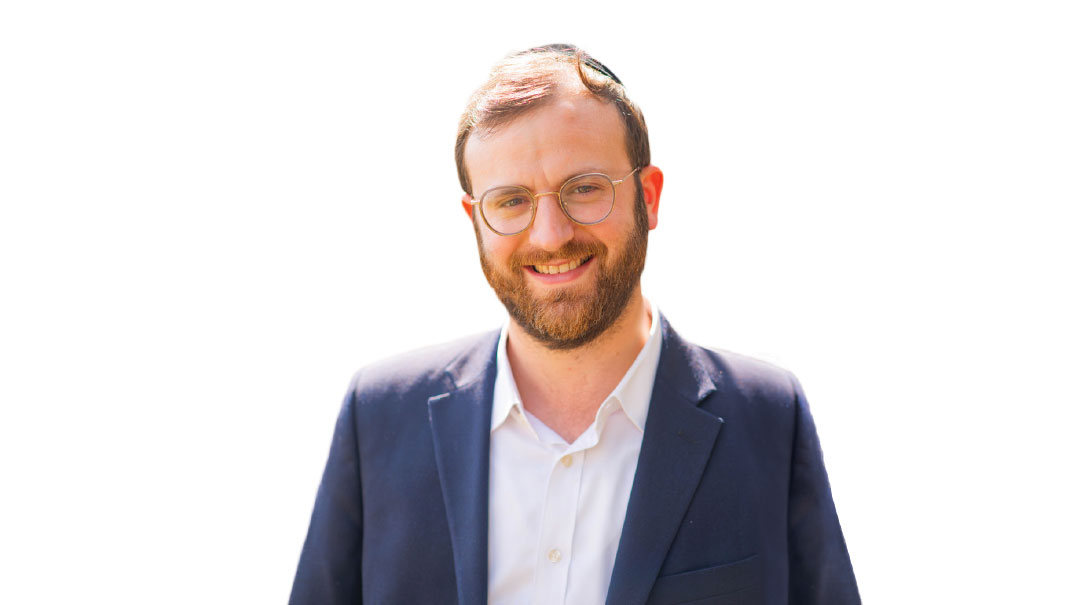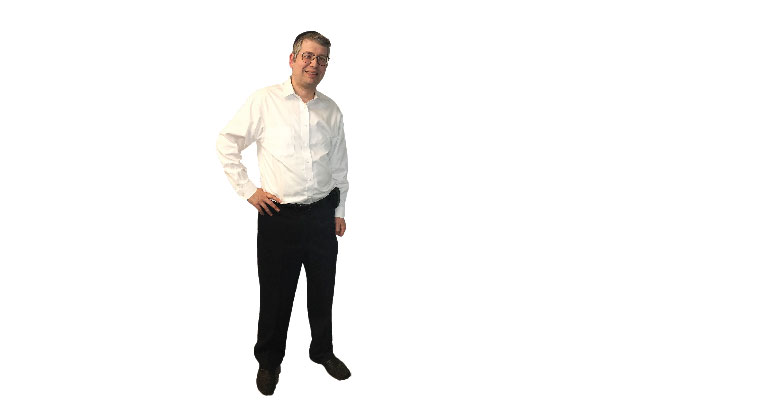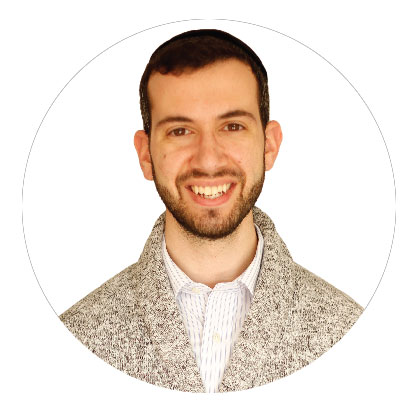A Day in the Life of Moshe Finkelstein

Moshe Finkelstein is the owner of CrunchTime Media in Brooklyn, New York

What I do
I produce promotional videos, focusing on the commercial, nonprofit, and not-for-profit spaces.
What that means
Anything from creating a series of campaign videos for a fundraising tzedakah organization to producing music videos and event promos.
How I got into the field
Twenty years ago, after learning in kollel for a few years, I needed to supplement my income. I wanted to continue in my yeshivah — baruch Hashem, I’m still there — so I had to come up with a side hustle that allowed for that. At the time, the video production industry was in its infancy. I liked to play around with home videos, taking them on my camera, so I figured I’ll give it a try. The demand for promotional videos was low back then, but there was the wedding industry. I offered to edit the videos of a friend who filmed weddings, and that’s how I started.
My training
Nothing formal. I bought Premiere Pro for Dummies, a book about the Adobe video editing program, asked my friend for something to work on, and got to work. It took many hours and sleepless nights, but I got the hang of it. Baruch Hashem, as my family grew, so did my business. I moved over to dinner and event productions once promotional videos became more common — not because the attitude changed, but because times changed. Back in the day, producing a promo video was difficult, expensive, and there was little return on investment. But once the technology advanced, videos could be made, distributed, and viewed easily. Now it’s a no-brainer — any business, in any industry, needs some kind of video. As for me, the skill is always evolving, because there’s always something to learn — and I need to keep up.
Why every institution needs a video for every event
I’m biased, but I have a hard time coming up with a reason not to have one. For a dinner to be successful, you need to run the show, stick to a schedule. When someone gets up to speak, you don’t know how long he’ll go, or worse, what he’ll say. With a video, you’re in control of the program, you avoid surprises or long speeches, and you can make sure no one says something that doesn’t fit your message.
My process
Usually, the client tells me the message they want to get across, we discuss concepts and styles, and we come up with a list of questions. I don’t send them to the interviewees because I want them to sound natural, not prepared. If a client has a specific vision, I go in with a detailed script and a shot list, but most of these videos are dictated by what the interviewees say, and I put it together based on that.
The biggest challenge
Making yeshivahs and Bais Yaakovs sound unique. Organizations have it a bit easier, because they’re filling an obvious specific need, so we focus on that. But I’ll ask what makes the yeshivah unique, and invariably, the answer is, “Our rabbanim are warm,” or “we focus on the individual talmid”— amazing, but every yeshivah feels the same way, so it's not so unique. Sometimes we work with a theme — tracking down alumni, for example, to highlight the success of the mosad. Another idea is "A Day in Yeshivas Whatever," following one bochur from Shacharis through night seder. One of the more out of the box ideas we did was a view of the yeshivah from the perspective of a fly on the wall — that was funny. Another time I did a bunch of interviews and challenged each interviewee to describe the school in 20 seconds without using clichés: no “warm,” “happy,” “caring,” you get the picture. That added an element of humor and got the point across.
Fun techniques
You know what B-roll is? Those shots where you hear a voiceover but are looking at images about the mosad and people there — the building, the block, classroom and hallways, kids milling around, arrival and dismissal, recess. Once I installed a camera outside a school for a few months. It sat in the same spot filming the scaffolding being removed and revealing their brand new facade. Another time, I installed multiple cameras for a few days to film the transformation of a warehouse to a beautiful dinner venue. These were stressful, there were plenty of technical issues, but they came out great.
The best part of my job
The interview process. I’ve met fascinating people over the years, from gedolim to Holocaust survivors to government officials to judges to regular people who are really anything but. These interviews teach me, time after time, how much we need to appreciate every brachah we receive and how to deal with problems or face adversity. I did a video with Yossi Hecht, who’s currently immobile from the waist down and receiving treatments. He encourages everyone to express gratitude to Hashem by saying the brachah Asher Yatzar with kavanah, or as he calls his initiative, “Asher to the Yatzar.” It’s powerful to watch Yossi face his challenges with a smile, using them as an opportunity to inspire others. And just today I spoke to the parents of a special needs child for the HASC concert. How can you not be moved hearing them frame it as a brachah — “He can’t talk, but he can walk and breathe on his own.” I won’t admit to crying…
How I draw out someone who’s nervous
So few people actually enjoy being on camera. Getting someone to feel comfortable in an interview is a skill, and it takes time to master. The first few minutes after I hit record are usually not about the subject we plan to discuss, we just talk about things we have in common — Jewish geography, of course, jobs, family, anything. Once I see they’re comfortable with me and their mind is off the camera, I get the real interview started. Over the years I can remember only one time where I couldn’t get anything but one sentence, no matter how hard we tried. After about 45 minutes we had to stop.
The most meaningful takeaways
Getting brachos from a Holocaust survivor — someone who walked out of the gas chambers at the last moment, or who blew shofar in Auschwitz, or who, after the war, when given the chance to do whatever he wanted to a Nazi captured by an American soldier, walked away saying, “That’s not how we do things.”
Mistaken identity
One of my first music videos was “Uforatzto” with Baruch Levine. We wanted to show Jews from all over the world, so I put out a call to my neighbors. I set up a studio in my living room, filmed them in front of a white screen, and edited them into the video. I labeled my Israeli cousin who happened to be here as “from France.” Five years later, he walked into some random shul in Eretz Yisrael, and someone he never met started talking to him in French! Needless to say, he doesn’t speak a work of French. This really drove home the power of videos — it was on screen for four seconds, pretty insignificant, but he was recognized years later.
Technical difficulties
I was once hired to video a large stage production; there was a lot riding on this job. One of my four cameraman couldn’t make it last minute, so he sent his inexperienced son instead. I gave him what I thought was the easiest job, the wide shot — all he had to do was hit record — and I ran my audio into his camera. But he had it on the wrong setting, so he got nothing. Baruch Hashem I was saved by the sound technician, who recorded a backup.
Things I’ve learned along the way
With experience, I can avoid major issues. But I did learn the hard way — I now know to hit record before I start interviewing! Also, always check the final version — and have it ready early. One of my most memorable incidents was back in the day, one of my first jobs, for a Melaveh Malkah. The edit was last minute, literally. By that I mean the Melaveh Malkah was well underway, hundreds of people were there, and the client was calling and asking, “Where’s the video?!” I was still in the office, editing. I exported the project by recording it onto the tape and ran out to deliver it. Because I was in such a rush, I didn’t check if the tape actually recorded it — I’ll never forget the feeling of watching the big screens, and to my horror, halfway through, the video just stopped.
My pet peeve
Over-dramatized videos. I can’t stress this enough: Not every video needs to be dramatic and with epic music — is that what you want the viewer to feel? The feeling you’re aiming for —impressed, moved, whatever — should dictate the pace and style. And aim for natural. Viewers don’t relate when it feels forced or rehearsed.
The interview I’ll never forget
A while ago, I drove down to Philly to get a statement from Rav Shmuel Kamenetsky for a yeshivah. As you can imagine, I was kind of intimidated. It was just me and the Rosh Yeshivah in his office upstairs. When you interview Rav Shmuel you don’t ask questions — it’s more like recording a statement — Rav Shmuel speaks and you record. As I was setting up and later packing to go, he started asking about my equipment — where I bought everything. I’m pretty sure he even asked if he could help bring it downstairs. I don’t think Rav Shmuel really had an interest in the difference between Canon and Sony, but it was an amazing lesson on what it means to make someone feel comfortable.
By the numbers
Footage per minute of produced video: Two to three hours of interviews for a five-minute video — and that’s not counting the B-roll. Editing can take two to three weeks.
Busy season
Things used to be crazy during the busy dinner season, from Chanukah until June, and I’d have summers off. Now everyone seems to be running campaigns, so it’s all year, though summers are still a bit slower.
Travelogue
I don’t usually travel, as most of my business is in the Tristate area. I fly to random cities a few times a year, but I try to avoid that and work with local companies. There was the time I went to Puerto Rico for the day right after the hurricane — there was no electricity in some places.
Quick tips about…
- Background music: Using music with lyrics is usually not a good idea, because it’s distracting and makes it hard to hear — and you’ll have viewers humming along with the song instead of focusing on your message.
- Background sound: Things like classroom noises — kids talking and laughing, the rebbi or morah teaching — is important; having just music with the interviewee or narrator produces a one-dimensional feel.
- B-roll: Ideally, you do the interviews and story before you shoot the B-roll, so you have a good idea of what you need. I like to keep things natural and just catch them in action —I avoid directing anyone. I don’t tell them where to walk or what to do.
My toys
Over the years, I’ve collected a nice variety of equipment — drones, action cameras, stabilizers. But it’s not really about the equipment. To create a video all you need is a phone and basic filming knowledge.
My motto
A picture is worth a thousand words. I add that a video must be worth millions, especially when it gets your point across in a clear, engaging way.
(Originally featured in Mishpacha, Issue 893)
Oops! We could not locate your form.






